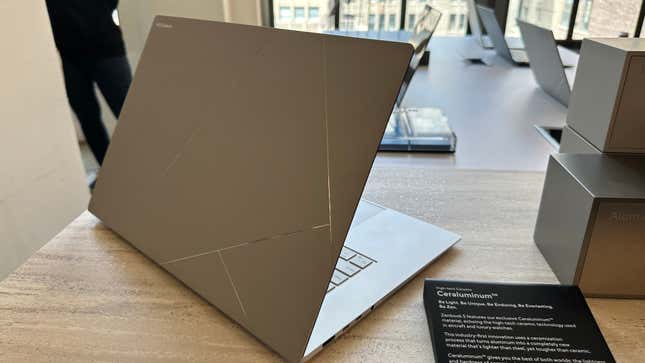What’s the new word of the day, kids? It’s “ceraluminum,” a real nonsense nomenclature combining ceramic and aluminum. That’s the new word to describe the next-gen Asus Zenbook S16 powered with the new AMD Ryzen 300 AI CPUs. But let’s ignore that for a second because some much more interesting ProArt PCs are coming down the pike that does more by stealing the best designs from the Asus ROG gaming line.
Gizmodo had the chance to look at some of Asus’ upcoming laptops. Still, while we weren’t impressed much with silly material nomenclature, we were with the wide slate of ProArts, which could be a go-to device for everything from work to design to gaming.
The weird wording is one thing, but looking at the new ProArts compared to the other new laptops from Asus, it seems like the ProArts kitchen sink attitude is the real thrust of this year’s laptop release. They’re packing some tried-and-tested hardware together into one package running on the nascent, untested AI-centric central processor from AMD. Based on a short time getting a feel for both the laptop and touchscreen models, I’m left very curious about how Asus has managed to take the best things from its gaming and productivity lines and put it all into a whole new line of Copilot+ devices.
What Does the New ProArt Line Look Like?

The base ProArt P16 laptop is supported in a new chassis ripped wholesale from the ROG Zephyrus G16. Why is that significant? It’s lighter and thinner than the older ProArt Studiobooks, and it makes use of the material that we already really liked from the material and design of the ROG Zephyrus G14.
Unfortunately, it won’t have the same 240 Hz OLED display but a 4K, 60 Hz screen. It doesn’t have the ROG-specific slash lighting as the Zephyrus either, though it will offer up to a Nvidia Geforce RTX 4070 discrete laptop GPU as well as the Ryzen AI 9 HX 370 CPU. There’s basically only one configuration, and it’s pretty pricey at $2,700. Still, it’s already available for preorder.
If the ProArt 16 feels nice but still relatively familiar, the new ProArt PX13 and PZ13 are far more of a departure. The PX13 is a 2-in-1 based on the same design as another older gaming product, the ROG Flow X13. It’s a 2.8K OLED display supporting HDR plus a GeForce RTX 4060 GPU. The 2-in-1 is going to cost $2,000 upfront, though it, too, should be available soon and is now on preorder.
That PZ13 is especially interesting in light of the Microsoft Surface Pro. Just like Microsoft’s own convertible, this platform runs on the Snapdragon X Elite chip and Apple’s M4 iPad Pro. It comes with a removable kickstand that is magnetically attached to the rear of the PC, while the keyboard hooks up to the bottom of the tablet portion.
The keys feel pretty nice, though still thinner than you’re probably used to if you haven’t used products like the Magic Keyboard, but it’s still a relatively light and versatile Windows-based tablet with a 13-inch, 3K OLED touchscreen.
Even better is the number of ports available. It has two USB-C ports and a full SD card reader. Unlike its two brethren, we’ll have to wait until Q3 this year to see the PZ13 in action.
How Does ‘Ceraluminum’ Feel?

Now that the line is split between the x86-based Ryzen and ARM-based Snapdragon CPUs, we’ll get to see who really comes out on top with both performance and power. All the other PCs coming this year from Asus’ lineup are similarly split. That Zenbook S16 we already mentioned is packing up to the Ryzen Ai 9 HX 370 as well as the 3K OLED, 120Hz touchscreen display. “Ceraluminum” does feel rather nice to touch. It feels ceramic-like, smooth but not plastic-y, and it still feels rather light. I like the overall look of the backplate and the off-white color.
Asus made a big deal about its new material and cool ventilation design, but how well these ultra-light laptops perform matters. I tested some of the new Copilot+ features on them, but none of them really seemed like they were designed to stress the capabilities of these laptops.
We’re starting to see the full scope of the new rendition of “Copilot+” PC. These are devices that have an NPU capable of supporting 40 TOPS (trillions of operations per second) for handling some amount of on-device AI. All that means right now is that there are a few new features like Recall and Procreate AI art generator on Microsoft Paint. For now, it’s best to ignore the whole discussion about neural processing power so long as there’s no killer app that makes it worth it.
The ProArts feel extra exciting because they look and feel like they’re taking in the best parts of Asus’ current design slate, “ceraluminum” not required.




















+ There are no comments
Add yours